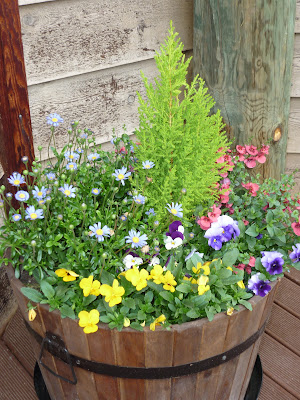Transforming the block at Gordon into a garden
Last post I showed you the block as it was in the beginning - a few ornamental trees, some shrubs and the ground completely covered by wood chips to which I added a few vases of potted colour here and there to please the eye.
The property was originally developed in 1992 by a local architect David Hamilton for himself and his family. It was one of the first properties built on the hill, Amber Ridge, in Gordon and he sure got the best pick of the bunch when it comes to the view.
The architect, after a couple of years, decided to relocate with his family to Queensland, a much warmer climate and subsequently sold the property to a university professor who lived alone. The professor unfortunately suffered from a terrible disability; polio had returned to haunt his later years and therefore he was not able to inject the required energy into further transforming the land. I suppose that is one of the reasons why only a few feature trees were planted and all the yard was covered with bark in order to reduce maintenance and suppress the weeds. Completely understandable. To be honest, I don't know how he managed. As I mentioned previously, you have to be pretty fit to live here -there are lots of stairs, steps and slopes both inside and outside the house. However I must say, the property looked very neat and tidy.
 |
| Potted colour around the house to make the garden a little more cheerful |
I was not sure I was doing the right thing changing the garden, particularly as many of my first plantings were unsuccessful. I tried to plants herbs I could use in cooking like rosemary, thyme, sage, basil, mint and tarragon. Only the rosemary survived. It didn't take long for the plants to wither and die. After watering, I started to check the soil and realised that the water was being absorbed by the wood chips and was not reaching deep into the soil to the roots of the plants. The soil beneath was dry as ever, even after considerable watering. Not that there was much soil anyway. The soil was mainly powdery wood from previously broken down bark or bright orange and brown clay.
 |
| Rosemary survived the tough dry conditions and heat |
To make the back garden look bigger we removed the rear wooden fence palings and replaced them with wire mesh. To my eye, it appears as though the property does not finish at the fence but instead continues into the distance. It's as though the nature reserve behind the back garden were farmland forming part of the property. Nonetheless, the removal of the fence resulted in being able to enjoy the views of the bushland and farmland on the hill. We also decided to remove the fences which separated the front and back gardens so as to be able to move freely from the front to the back of the block and enjoy the views all round. Our neighbours also benefited from the new views.
 |
| Removal of the wooden fence opened up the view to the nature reserve behind the back garden |
As for the front of the block - I created a path with all the rocks I found lying around the block or had been dug up when planting. It goes to show how many rocks there were as I was able to create a path from the front steps of the house, across the front garden and up the south side of the block. There are still many more rocks and stones. I chose to start an initial planting of hardy, drought tolerant plants to create a cool green effect in the front garden. My brother and sister in-law were rennovating their garden at the time and kindly gave me quite a few blue bearded irises. I divided the clumps of irises and spread these throughout the garden beds in a naturalised fashion. The irisies have done well and I was able to get the desired effect. In the next few years the irises should mature and multiply adding to this effect.
 I realised that once the initial planting had become established, it has now become easier to plant other varieties of plants, even more delicate ones which require moist conditions. Subsequent plantings have been successful and maintenance less fought with difficulty. The soil has improved somewhat with leaf litter, compost and of course the trusted horse manure.
I realised that once the initial planting had become established, it has now become easier to plant other varieties of plants, even more delicate ones which require moist conditions. Subsequent plantings have been successful and maintenance less fought with difficulty. The soil has improved somewhat with leaf litter, compost and of course the trusted horse manure.Finally, I'm on my way to creating a healthier, more fruitful and attractive garden.

No comments:
Post a Comment